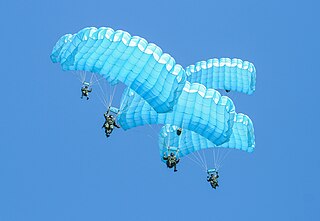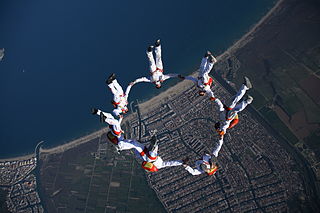Boardsports are active outdoor sports that are played with some sort of board as the primary equipment. These sports take place on a variety of terrains, from paved flat-ground and snow-covered hills to water and air. Most boardsports are considered action sports or extreme sports, and thus often appeal to youth. Some board sports were marginalized in the past. However, many board sports are gaining mainstream recognition, and with this recognition, they have enjoyed wider broadcast, sponsorship and inclusion in institutional sporting events, including the Olympic Games.

Freeflying is a skydiving discipline which began in the late 1980s, involving freefalling in various vertical orientations, as opposed to the traditional "belly-to-earth" orientation. The discipline is known to have originated when Olav Zipser began experimenting with non-traditional forms of bodyflight. Zipser founded the FreeFly Clowns as a two-person competitive team with Mike Vail in 1992. He was joined by Omar Alhegelan, Charles Bryan, and Stefania Martinengo in 1994. The FreeFly Clowns are also credited with opening the first school to teach freeflying, The First School of Modern SkyFlying.

Bodyboarding is a water sport in which the surfer rides a bodyboard on the crest, face, and curl of a wave which is carrying the surfer towards the shore. Bodyboarding is also referred to as Boogieboarding due to the invention of the "Boogie Board" by Tom Morey in 1971. The average bodyboard consists of a short, rectangular piece of hydrodynamic foam. Bodyboarders typically use swim fins for additional propulsion and control while riding a breaking wave.

A drop zone (DZ) is a place where parachutists or parachuted supplies land. It can be an area targeted for landing by paratroopers and airborne forces, or a base from which recreational parachutists and skydivers take off in aircraft and land under parachutes. In the latter case, it is often beside a small airport, frequently sharing the facility with other general aviation.

Wingsuit flying is the sport of skydiving using a webbing-sleeved jumpsuit called a wingsuit to add webbed area to the diver's body and generate increased lift, which allows extended air time by gliding flight rather than just free falling. The modern wingsuit, first developed in the late 1990s, uses a pair of fabric membranes stretched flat between the arms and flanks/thighs to imitate an airfoil, and often also between the legs to function as a tail and allow some aerial steering.
Tracking is a technique used by skydivers during freefall to increase their horizontal speed. Tracking is considered a fundamental skill in the sport because it allows multiple skydivers to gain separation from each other prior to deploying their parachutes. Nearly all licensing organizations mandate a student show proficiency at tracking in order to obtain their skydiving license.

Accelerated freefall (AFF) (known in Canada as progressive freefall, and in Finland as Nova (NOpeutettu VApaapudotus, a literal translation)) is a method of skydiving training. This method of skydiving training is called "accelerated" because the progression is the fastest way to experience solo freefall, normally from 10,000 to 15,000 feet above ground level (AGL). In static line progression, more jumps are required to experience freefall, but the jumps are less expensive for the student as one instructor can dispatch multiple students per load and students are initially dispatched from lower altitudes. Under accelerated freefall, one or sometimes two instructors are dedicated just to one student.

A vertical wind tunnel (VWT) is a wind tunnel that moves air up in a vertical column. Unlike standard wind tunnels, which have test sections that are oriented horizontally, as experienced in level flight, a vertical orientation enables gravity to be countered by drag instead of lift, as experienced in an aircraft spin or by a skydiver at terminal velocity.
Freestyle skydiving is a competitive skydiving discipline where one member of a two-person team performs acrobatic manoeuvres in free fall while the other one films the performance from a close distance using a helmet-mounted camera.

Roger Warren Nelson was a skydiver and founder of Skydive Chicago, one of the largest skydiving centers in the United States.

The Parachute Association of South Africa (PASA) manages the sports of parachuting and skydiving in South Africa on behalf of the South African Civil Aviation Authority.

Banzai skydiving is a rumored form of skydiving in which the skydiver throws their parachute out the airplane door, waits, and then jumps after it. To be successful, the skydiver must catch the parachute, secure it, and glide to the projected landing zone. There is no known, credible evidence that a banzai skydive has ever really occurred according to its definition.

Parachuting and skydiving is a method of transiting from a high point in an atmosphere to the ground or ocean surface with the aid of gravity, involving the control of speed during the descent using a parachute or parachutes.
A big way is a type of formation skydiving involving a large group of skydivers coming together while in freefall to form a specific and predetermined formation. All the skydivers involved aim to connect with each other and hold the complete formation for a designated period.
Red Bull Stratos was a high-altitude skydiving project involving Austrian skydiver Felix Baumgartner. On 14 October 2012, Baumgartner flew approximately 39 kilometres (24 mi) into the stratosphere over New Mexico, United States, in a helium balloon before free falling in a pressure suit and then parachuting to Earth. The total jump, from leaving the capsule to landing on the ground, lasted approximately ten minutes. While the free fall was initially expected to last between five and six minutes, Baumgartner deployed his parachute after 4 minutes and 19 seconds.
Troy Hartman is a professional aerial stuntman, skydiver and inventor. He is an X Games gold medalist for skysurfing and accomplished television host for many shows, most notably the MTV series Senseless Acts of Video. He was the face of the award-winning 1998 Pepsi Super Bowl commercial.

Olav Zipser is a German professional skydiver.

Skydive Empuriabrava is the brand that has been commercially operating Empuriabrava Aerodrome since 1985. Since it began operating its main activity has been skydiving although it also offers photo flights, aerial and tourist advertising, and runs a school of aviation for private pilots.

Babylon Freefly is a French skydiving team that was formed in 1998 by Stephane Fardel in Empuriabrava, and has grown into one of the oldest and most successful freeflying teams in the history of skydiving.
Omar Faisal Alhegelan is an International Skydiving Hall of Fame inductee, keynote speaker, stuntman, actor, model and businessman from Saudi Arabia. He is recognized for his contribution to the freefly skydiving discipline. He is a multiple Skydiving World Champion and has received every accolade possible in the field of Freestyle & Freely skydiving throughout his career.















